Original | Keisan.hl (@KeisanCrypto)_
Editor | Odaily Planet Daily (@OdailyChina)
Translator | Dingdang (@XiaMiPP)
Editor's Note: In today's crypto market filled with bubbles and narratives, why has Hyperliquid (HYPE) been able to join the ten billion market cap club in such a short time? Is it the result of temporary hype, or does it stem from the long-term value of its own products and mechanisms? The author, Keisan.hl, starts from the token economic model and combines a horizontal comparison of traditional finance and leading crypto projects to systematically sort out Hyperliquid's current market performance and potential logic, constructing a relatively complete valuation framework. 
It has been about six months since I first published a valuation framework for HYPE. During this time, many things have changed, but many things have also remained the same. My optimism about HYPE remains unchanged.
Let's take a look at some data.

Revenue Estimation (Underwriting Revenue)
One of the biggest challenges in assessing HYPE is how to make a reassuring valuation for annual revenue (i.e., cash flow). Hyperliquid is an early-stage startup that is growing rapidly. Therefore, you might consider incorporating growth into your numbers. However, it is also in a cyclical industry, where bear market trading volumes may be about 50% lower than in bull markets. My personal view is that Hyperliquid's rapid user growth, capital inflow, and other positive catalysts will be sufficient to offset the decline in trading volume during bear markets. From the growth observed over the past six months, average daily revenue has significantly increased, validating this.
As for the changes in trading volume during bear markets, I believe that even if Bitcoin enters a bear market in the short term, the decline in trading volume will not be as severe as before, due to the continuous inflow of ETF funds and the current more favorable U.S. policy towards cryptocurrencies. Of course, this is still a factor to consider, and revenue may decrease by about 50% over the next few years, so we will conservatively use the recent average trading volume from the bull market as our baseline (3 million USD), not accounting for growth.
Odaily Note: The author of this article published a valuation framework in January, and we still use the original valuation method to explain the chart data during compilation.
A valuation multiple consists of two core elements: price (valuation) and earnings (revenue/fees).
First, I have broken down the fee data for different time periods.
Then, I examined the total supply of the token from two dimensions: circulating supply and adjusted fully diluted supply.
- Circulating supply is easy to understand; it is the number of tokens currently in circulation in the market, roughly equal to the amount distributed through airdrops, minus the portion destroyed through HIP (governance proposals) and repurchased by the assistance fund.
- The concept of fully diluted supply often confuses people, as many mistakenly believe it is a reference value that must be used when assessing project valuation. In fact, HYPE's fully diluted supply is fixed (no inflation), with 38.888% reserved for future token releases and community rewards. Additionally, 3% is allocated for community funding programs, 1.2% has been repurchased by the fund, and 0.1% has been destroyed through HIP transaction fees.
In my calculations, I have excluded the repurchased and destroyed portions, as well as the unreleased tokens for future releases/community funding. My assumption is that a large portion of the 38.888% of tokens will be gradually released over a long time in the form of staking rewards. As for the community funding portion, I believe it is a positive expected value (+EV) investment aimed at strengthening the community and ecosystem.
Among the remaining unreleased tokens, 23.8% are reserved for the team and future members, and 6.0% are reserved for the foundation. I have fully included these two portions in the adjusted supply, but this assumption is somewhat conservative, as the team is unlikely to sell or distribute these tokens in the short term. The release pace of these tokens is very slow, so they should be given a high discount in the valuation. It is important to emphasize again that this team does not need to cash out or realize liquidity events.
Personally, I believe the most reasonable valuation base token quantity should lie between the circulating supply and the adjusted fully diluted supply.
The price-to-earnings ratio (P/E) calculated based on 7-day data is as follows:
- The P/E ratio based on circulating supply is approximately 12.3 times
- The P/E ratio based on adjusted fully diluted supply is approximately 21.9 times
I believe the most reasonable valuation benchmark should lie between these two. We can call it the Blended P/E Multiple, approximately 17.1 times.
Comparisons with Public Companies (Comps)
We now enter the most interesting part of the valuation: comparisons with public companies. HYPE's current price is very cheap.
If you have been following me, you should have heard me say multiple times, "No one knows how to value HYPE." Indeed, many people have not figured out the logic behind it, especially how the team tokens are accounted for in the fully diluted total supply (FDV) and how this aligns with traditional public companies.
Public companies typically issue a type of stock reward called "Stock-Based Compensation" (SBC), mainly for the executive team and core employees. Many analysts tend to view these as one-time expenses and do not include them in the company's operating expenses. But I do not see it that way. In my view, treating recurring annual expenditures amounting to hundreds of millions of dollars as one-time expenses is extremely unreasonable.
I can confirm that the SBC of Coinbase (COIN), Robinhood (HOOD), and Circle (CRCL) accounts for about 25% of their adjusted EBITDA, and this ratio has persisted for many years. These are not one-time issuances but real, ongoing equity expenditures. They directly enter the pockets of executives through stock issuance while also diluting the equity of existing shareholders. This is a real cost.
Therefore, if we are to include these expenditures in the valuation, we must exclude the stock options that have already been accounted for in the equity, as they will gradually unlock over the next few years. I have made the corresponding adjustments in the "LTM multiples (excluding SBC)" column, removing the "to be issued" SBC stocks and reclassifying the SBC amount as an expense (these companies often exclude this portion when reporting EBITDA).
Why is this crucial? Because many people evaluating HYPE account for 100% of the tokens held by the team in the FDV but overlook that public companies actually have "unlimited FDV," as they can continuously issue SBC to executives every year.
So, how can we achieve a fair and comparable valuation method? My approach is as follows:
- If you want to compare using the net cash flow received by actual shareholders, then use the "LTM multiples (excluding SBC)" to compare public company valuations while accounting for 100% of Hyperliquid's team tokens in the total supply.
- If you want to adopt the public companies' common "adjusted EBITDA" reporting standard (i.e., not considering the sustainability of SBC), then use the "Blended Supply Multiple": circulating tokens (excluding team tokens) + team tokens accounted for at 50%. This assumes that the team has already received half of them, and the remaining half will be gradually released over the next few years, just like SBC.
It is worth mentioning that SBC is infinitely issued, while team tokens have a limited total supply. You can see that regardless of the valuation method used, HYPE appears extremely attractive.
Finally, let's talk about profitability. Coinbase, Robinhood, and Circle have significantly lower free cash flow profit margins than Hyperliquid. This means that when their revenues decline, EBITDA will shrink significantly, while expenses remain large. In contrast, Hyperliquid's free cash flow is cleaner, more sustainable, and has stronger defensive capabilities.
Additionally, one more data point: Coinbase has 4,300 employees, Robinhood has 2,500, while Hyperliquid's core team consists of only 12 people.
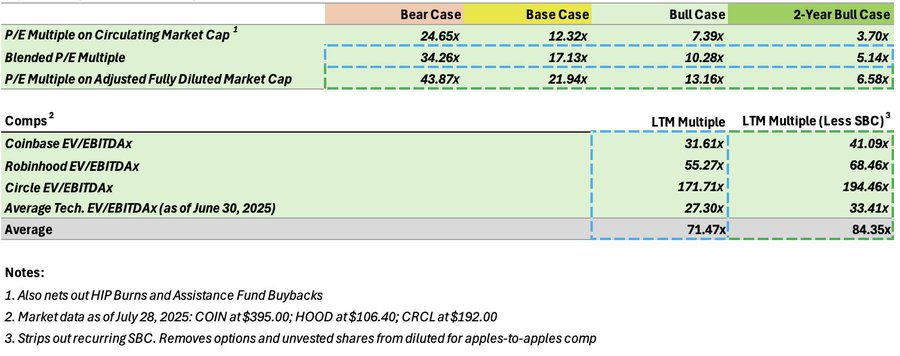
HYPE's Bull Market Expectations
When it comes to bull market expectations, I believe most people seriously underestimate HYPE's potential. They only value it based on current revenue and simply discount the bull market premium.
But have they considered how large the TAM (Total Addressable Market) of this market really is?
Perpetual contracts are one of the largest markets in the crypto space, second only to stablecoins. Currently, Hyperliquid accounts for about 10% of the perpetual contract market. Its share in the spot CLOB (Central Limit Order Book) market is even lower.
More importantly, HyperEVM has just started. The upcoming HIP-3 and various new types of perpetual contracts will expand Hyperliquid from a "crypto perpetual contract platform" to a "perpetual trading platform for all global assets." Some of the directions I am most looking forward to include stocks, pre-IPO private companies, prediction markets, foreign exchange, commodities, etc.
Perpetual contracts are the best financial products on Earth, and Hyperliquid is the "AWS of perpetual contracts," with strong scalability, fully decentralized, and transparent.
The traditional financial world and other non-crypto circles have not yet truly understood the power of perpetual contracts. But once this product is discovered, its potential will be enormous.
Back to the numbers. Six months ago, when I first wrote the valuation framework, Hyperliquid generated about 1 million USD in daily revenue (at that time, due to the launch of TRUMP, trading volume surged temporarily). Now, this number has stabilized between 2.5 to 3 million USD per day, more than doubling. User and capital inflow have also increased simultaneously.
Currently, Hyperliquid accounts for about 5% of all CEX trading volume. Imagine if this number reaches 25% in the coming years, which would mean daily revenue could rise to 15 million USD. Based on this, the free cash flow valuation multiple for HYPE would drop to 5 times.
Comparison with Other Crypto Tokens
Comparing HYPE with other tokens is somewhat unfair, as there are not many truly comparable projects.
The only references available are a few memecoin launch platforms with strong product-market fit (PMF) that can generate stable cash flow, such as BONK, GP, and PUMP.
I hold positions in BONK and GP and believe they are among the most undervalued projects currently, aside from HYPE.
I had previously made a long-term investment in PUMP but have since reduced my position. I believe they have already exited the competition, which is understandable. Their model lacks a moat and is easily disrupted by other platforms. In contrast, BONK's non-exploitative model is winning, as evidenced by data across various chains.
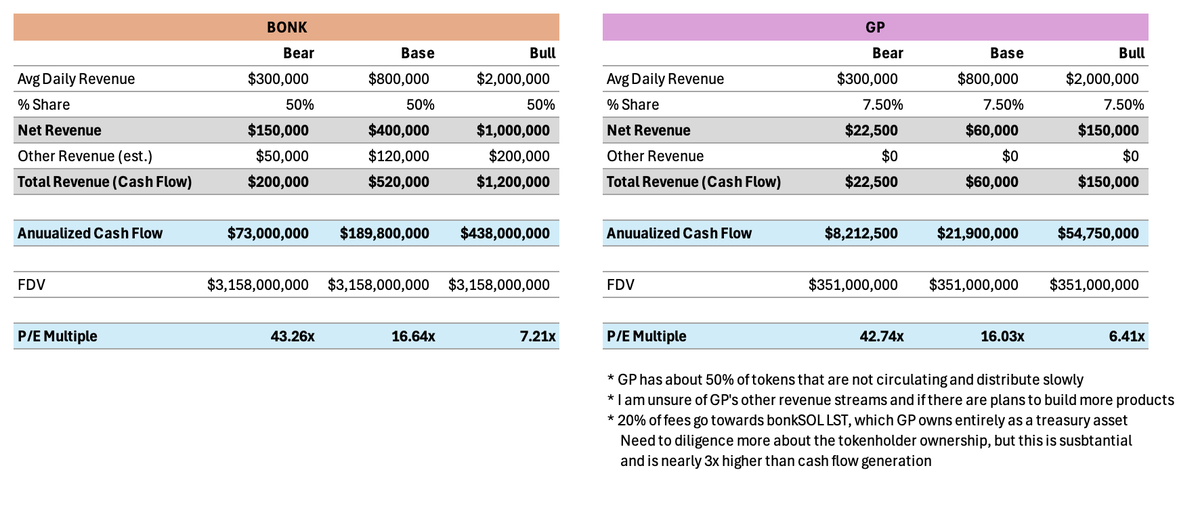
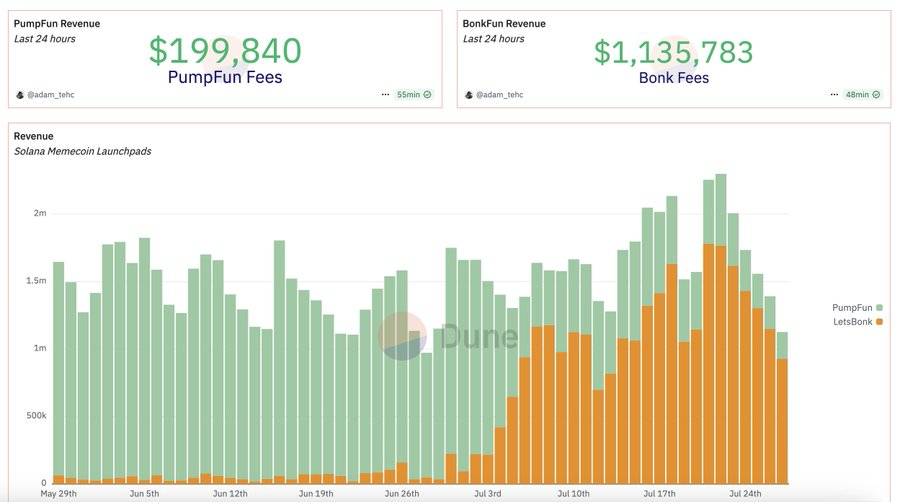
Attention from Traditional Finance
Traditional finance is entering the crypto space. Since the launch of ETFs, Bitcoin and Ethereum have attracted between 50 to 100 billion USD in capital inflow, setting a historical record for ETFs.
So, what assets are traditional finance most likely to favor? Of course, those that can generate substantial cash flow, have a sustainable moat, and possess strong defensive models.
A Bloomberg analyst once asked, "What exactly is behind Hyperliquid?" While this question may seem sarcastic, it reflects the core doubts that traditional finance has had about crypto for years.
Now, we finally have an answer, and it is a comprehensive one.
HYPE has not yet been widely discovered in traditional finance circles, simply because the team has not engaged in any marketing. If it were another team, they would have already made thousands of calls to attract investment. But Jeff and the team have their own style.
However, do not be misled by appearances. Wall Street will eventually discover HYPE.
I believe that once SONN goes live, it will mark a significant turning point. SONN has 300 million USD in reserve funds to purchase HYPE and will promote HYPE comprehensively alongside Paradigm and Galaxy Digital.
Odaily Note: SONN is Sonnet BioTherapeutics, which has reached a business merger agreement worth 888 million USD with Rorschach I LLC, transforming it into a crypto reserve company named Hyperliquid Strategies Inc. (HSI).
This purchasing power is equivalent to 48 billion USD in Bitcoin purchasing power (this year, Bitcoin ETFs have only absorbed 15 billion USD in capital inflow). It can be considered a super catalyst.

Token Distribution
Currently, HYPE has only about 150,000 holding addresses, a number lower than many memecoins on Solana (for example, the number of SOL holders has exceeded 10 million).
The issue is that the current distribution channels for HYPE are not smooth, making it difficult for ordinary users to buy in. Most existing holders have already made substantial profits and may not have a strong incentive to continue accumulating. This could suppress price increases.
But everything is changing. Coinbase and Binance have refused to list HYPE for obvious reasons. However, many front-end and fiat entry points are being built for Hyperliquid. Phantom has launched a perpetual contract front-end based on Hyperliquid builder code, attracting 15,000 to 20,000 users within two weeks. Utilizing this distribution network could be a significant catalyst for $HYPE, along with other distribution networks currently under construction. Treasury companies like SONN and HYPD are also expected to become good distribution networks, not just for large funds from traditional finance. This may take time and will become more significant as they mature.
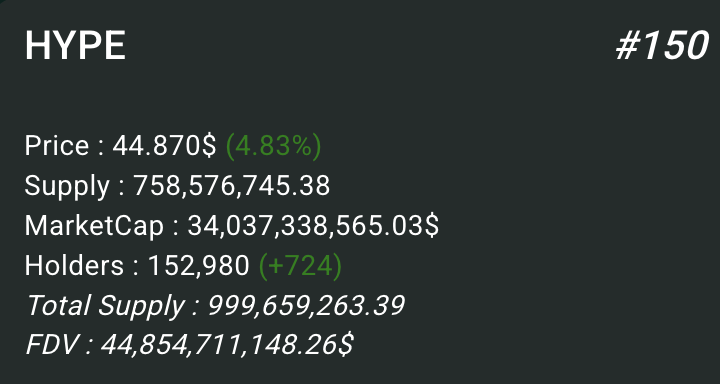
Data Performance
Hyperliquid's data performance is impressive, even among the best in all cryptocurrencies. After Hyperliquid recently experienced tremendous growth, it is astonishing to see the current price position. I will just share a few charts.
User growth has reached a new high since TGE, capital inflow has accelerated to historical highs, and open interest (OI) has also reached historical peaks.
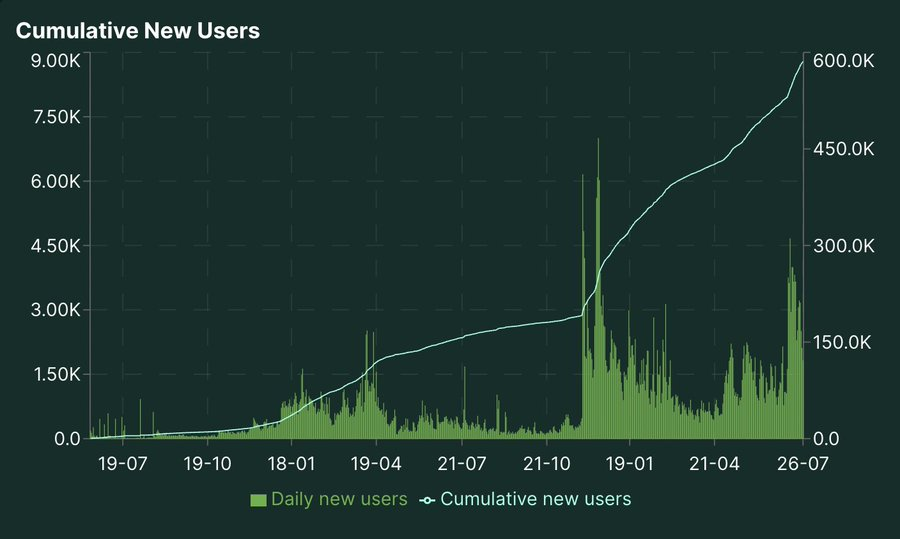
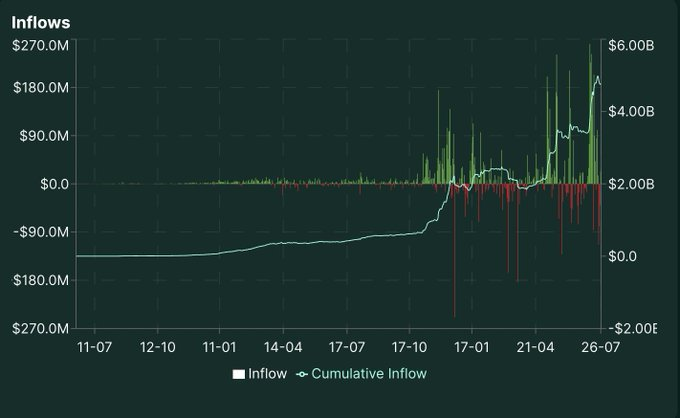
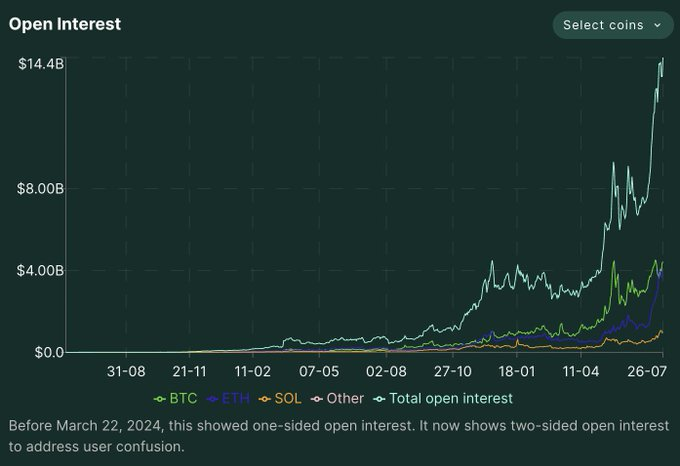
Comparison of Hyperliquid and CEX data: trading volume compared to CEX is at an all-time high; open interest compared to CEX continues to break historical highs.
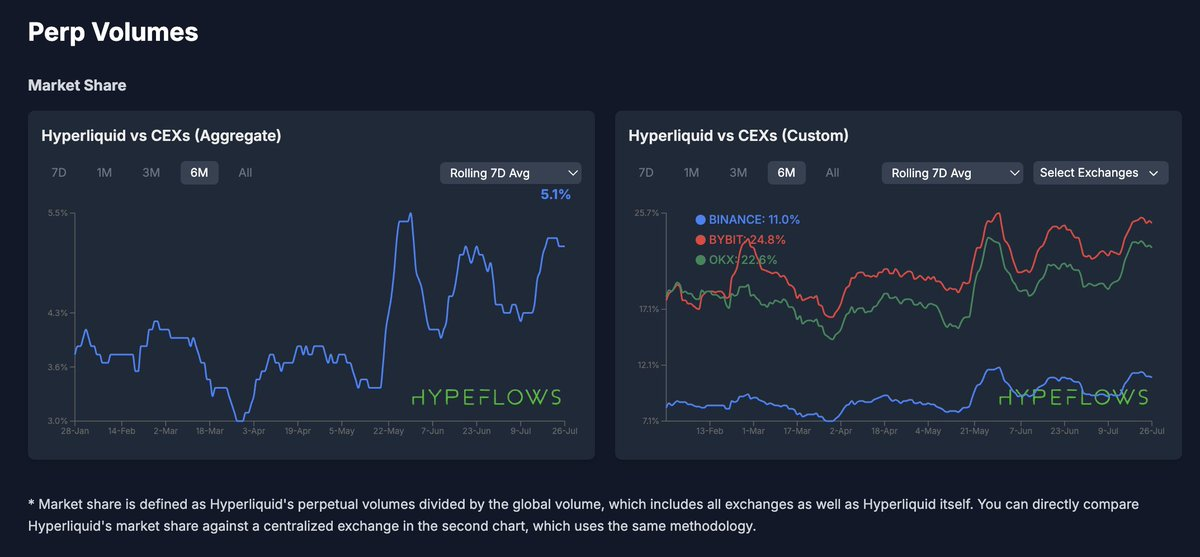
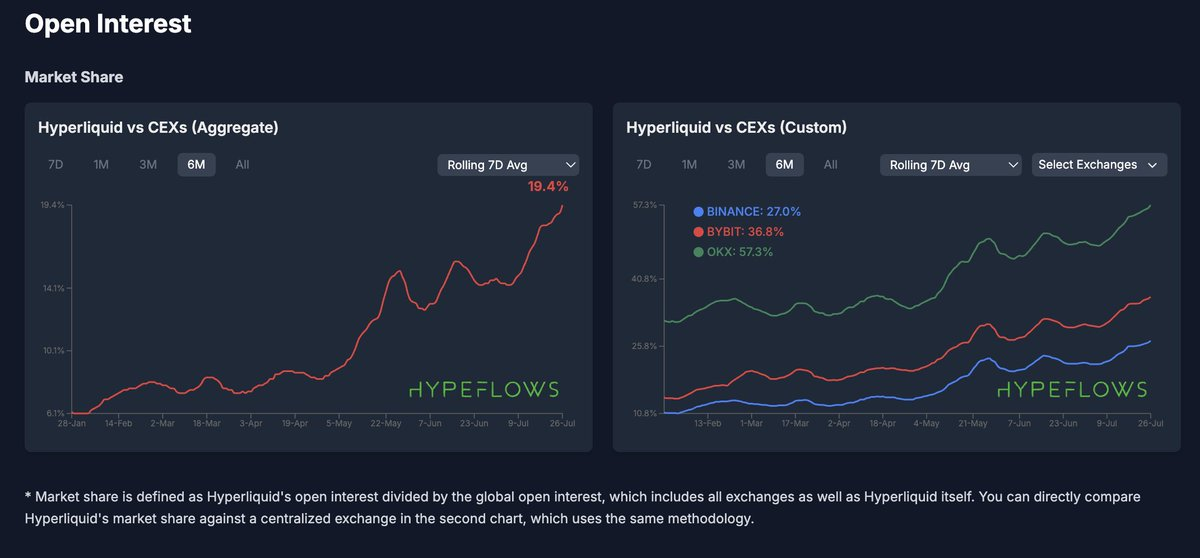
At the same time, the SWPE (relative premium indicator) is at its lowest point since April, suggesting that the current price is attractive.
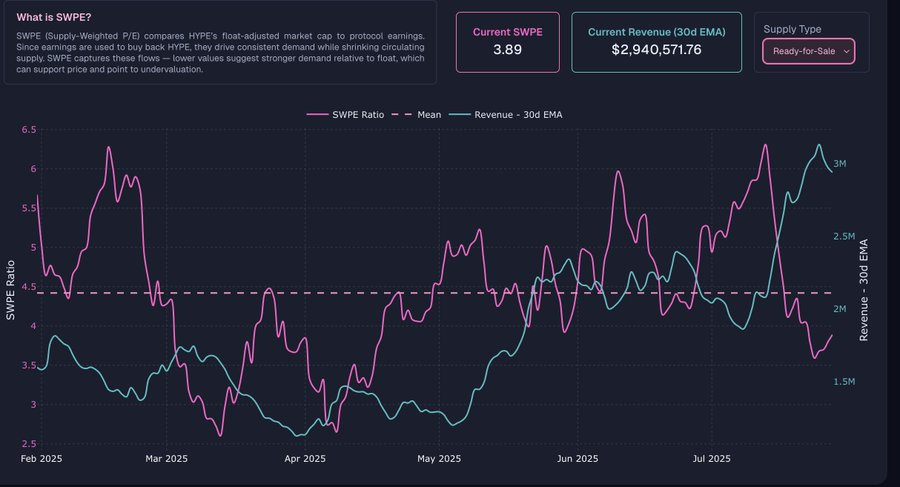
Drivers of the Next Growth Phase
The key factors I believe will drive HYPE's growth include:
- Front-end distribution: The builder code is one of Hyperliquid's best innovations. The front-end will also engage in marketing, while Hyperliquid has never done any marketing to date.
- Construction of fiat entry points: I have heard from several different sources (not directly from Hyperliquid, but from applications or front-ends related to Hyperliquid) that this is about to launch.
- HIP-3: A new product that may only be realized on Hyperliquid, which will bring significant token burns for HYPE.
- SONN: It will bring Wall Street funds into HYPE and inject 300 million USD in buying pressure for HYPE.
- Spot collateral for perpetual contract trading: Based on the deployment status of the testnet, this seems to be in progress, and I believe it will be a significant unlock for the platform and HYPE tokens. We may see an increase in trading volume, and BTC whales may also deposit funds into Hyperliquid as a result.
- More spot assets going live. @hyperunit has been working hard and continues to list top assets. The launch of PUMP was very successful, proving the strength of our team. Hyperliquid listed perpetual contracts before TGE, and @hyperunit immediately launched spot trading at TGE, quickly forming the thickest order book. Both events were significant user acquisitions, as evidenced by the capital inflow from those days.
These are just some of the catalysts. I have been writing for over an hour and still cannot cover everything.
Conclusion
HYPE's current valuation remains very cheap; you may not hold enough, and you might not fully understand its potential yet.
HYPE's current valuation remains very cheap; you may not hold enough, and you might not fully understand its potential yet.
免责声明:本文章仅代表作者个人观点,不代表本平台的立场和观点。本文章仅供信息分享,不构成对任何人的任何投资建议。用户与作者之间的任何争议,与本平台无关。如网页中刊载的文章或图片涉及侵权,请提供相关的权利证明和身份证明发送邮件到support@aicoin.com,本平台相关工作人员将会进行核查。




